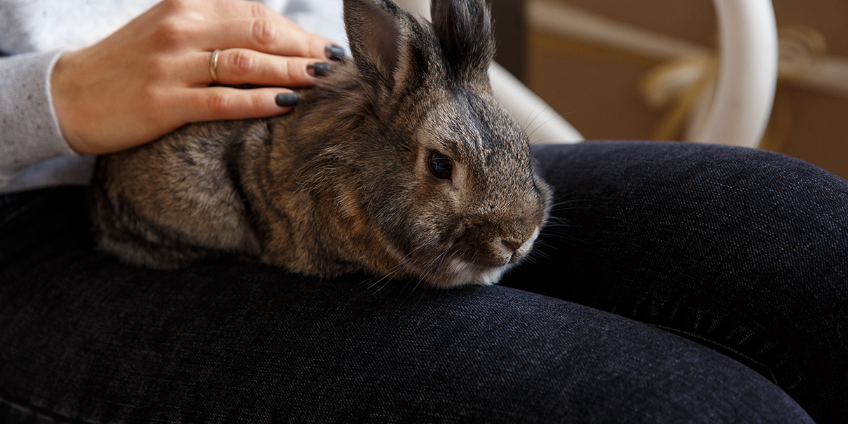
Everything You Need to Know Before Bringing a Pet Rabbit Home
General Advice
Small Animals
05/05/2023
I couldn’t resist the two little lop-eared bunnies that fit into the palm of my hand, their noses twitching and their fur so soft and beautiful.
However, before taking my furry friends home, I realised I didn’t know anything about raising rabbits. Would they like living outside on the deck? Would they get along as a pair? What should they eat? I decided to do some research and here’s what I discovered…
Choosing your rabbit
There are many breeds of rabbit, each as lovable as the next, but some are more suitable as pets than others. The smaller dwarf varieties, such as my mini lops, are very popular and a good choice for younger children who will be able to handle them easier than large breeds like the Flemish Giant. Long-haired Angora rabbits are another beautiful breed, but require the commitment of daily grooming.
Rabbits need to be at least eight weeks old before they can leave their mother. When I visited the rabbit breeder, I looked for a bunny that was lively and active, with bright eyes, clean ears and tidy fur.
Bunny Girl and Bunny Boy had never left each other’s side, but a pair of rabbits living together can be temperamental. Because they are such social animals, having two is a good choice, but look for two females, or a female and neutered male. Un-neutered males over the age of three months will fight.
Choosing the perfect hutch for your rabbit
Rabbits need a spacious hutches or cages that allows them to stretch out and stand on their hind legs. It should have two compartments – one cosy enclosed section for sleeping and an open area with strong wire mesh. To keep your bunny warm at night, put a layer of organic litter or wood shavings with a deep layer of straw or shredded paper in the sleeping quarter. The bottom of the sleeping area should be solid so it doesn’t hurt your bunny’s paws and, if possible, raised off the ground. The roof should be sloping and overhang the sides to keep the rain away. Place the hutch in a well-ventilated, sheltered position, away from direct sunlight. Morning sun is best.
Clean your rabbit’s cage regularly, and their toilet corner every day. Try to use a mild detergent because rabbits have a very strong sense of smell!
Your rabbit will spend hours sunbathing and relaxing in its home, but just like its wild relatives, will absolutely love to run free and fast. So, as well as a comfortable hutch, it’s great for your bunny to spend time in a playpen on the grass, where it can run around in the open air. I often take my pair to a friend’s lush green garden on pet leashes – they love it!
Rabbits can also make good indoor pets. They can be trained to use a litter tray and love to spend time with their human family. Bunny Girl and Bunny Boy love their inside time and after exploring, sit on my lap and watch TV. If you do give your bunny free rein, make sure they have a safe and secluded place to hide, such as a cardboard box with holes cut out. Remember to keep dangerous items, like plants, electric cables and poisonous objects, out of reach of these famous chewers.
Keeping your rabbit healthy
Good food, a clean and dry home, exercise, grooming and plenty of cuddles are the essentials for a happy and healthy pet.
Handling your rabbit on a daily basis is the perfect chance to check your pet for signs of ill health. Look out for mites, wounds, lumps, or discharges from the eyes, ears and nose. Other signs to look out for include not moving around like normal, sneezing, a poor appetite, swollen tummy and head tilt. If there’s anything unusual, consult your vet.
Check that your rabbit’s front teeth are not getting too long. A bunny’s incisors continue to grow throughout its life, so rabbits need plenty of hard food and a gnawing block to keep them in check. Otherwise, a vet will have to cut them back. Nails also have to be trimmed if your rabbit doesn’t have the chance to wear them down naturally on hard ground.
Diarrhoea is a common problem for rabbits, often the result of dietary changes. I found that introducing more than one new food too quickly didn’t sit well with my bunnies’ tummies! If your rabbit has diarrhoea for more than 24 hours, be sure to pay a visit to the vet.
Playtime with your bunny
Handle your bunny gently from an early age. Pick it up by placing one hand under the chest, the front legs between two fingers, with the hindquarters supported with the other hand. Cradle it against your body.
Rabbits love to play and it is easy to find suitable toys and games for them. They love to rip things up, toss things around and burrow. I gave my two rabbits an empty toilet roll and small ball to push around, and it keeps them amused for hours.
You could make tunnels and obstacle courses out of boxes or wood to keep them stimulated, or fill a box with hay, newspaper or old towels so they can shred and burrow away to their heart's content! Hard plastic baby toys, wooden chew toys and hanging bird toys will also keep your bunny happy.
Rabbits are very sociable animals, and the more time you spend grooming and petting them, the happier, tamer and more affectionate they will become.
What to feed your rabbit
Your rabbit will thrive on a varied diet of pellets, hay and fresh fruit and vegetables. Good-quality hay and pellets should form the basis of your bunny’s diet, with unlimited hay being provided in a rack to prevent it getting soiled.
Fresh vegetables are another essential part of your rabbit’s diet because they contain a variety of nutrients. Fresh fruit is like a treat for your bunny – they will love the taste, but need to be fed it in moderation – perhaps one piece a day. See the list of recommended fruit and veg below.
Be sure to introduce any new foods slowly, to see how your rabbit will react and to prevent digestive problems.
A drip-feed bottle of water should be refilled every day, and a salt lick and vitamin/mineral block are good additions to your pet’s cage.
What’s on the menu?
You can feed these to your rabbit regularly:
- apple
- banana
- beetroot
- broccoli
- carrot
- celery
- celeriac
- cucumber
- fennel
- melon
- parsnip
- peas
- pear
- pumpkin
- raspberry
- strawberry
- tomato
- watercress
- watermelon
You can feed these to your rabbit a little:
- brussels sprouts
- cabbage
- cauliflower
- lettuce
- maize
- potato
- spinach
- swede
- turnip
You should avoid feeding these to your rabbit:
- tomato leaves
- beans
- potato sprouts
- rhubarb

Written by The Pet.co.nz
Team
Written by The Pet.co.nz Team
A team of specialists with backgrounds in animal nursing, animal care, and all things pet related.